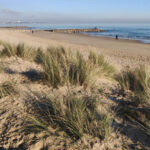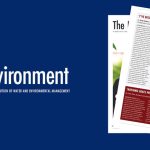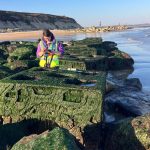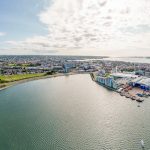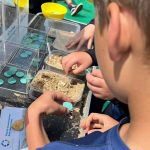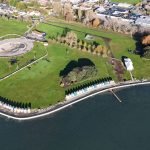Originally posted 9th May; updated 11th December 2023
Featured on BBC Countryfile
Countryfile’s Ellie Harrison meets Bournemouth University’s Marine Biologist – Rick Stafford and PHD Researcher – Jess Bone to hear about findings of a 3-year study to enhance biodiversity in and around Poole Harbour. Rockpools feature on this videoclip from 3:20 min. The programme aired on 3 Dec 2023.
© BBC
© Bournemouth University
A series of artificial, concrete rockpools, bolted onto harbour walls in Poole and the Isle of Wight have provided a safe habitat for an abundance of marine life, scientists have found.
A team from Bournemouth University installed 114 of the artificial rockpools – shaped like a typical bathroom sink – across three sites in 2020. For the past three years they have been monitoring the species that inhabit them and comparing the results to species residing on the sea walls.
The findings show that this could be an effective way to improve coastal ecosystems by helping nature to thrive in urban ports and harbours.
“As our coastlines become more developed, marine species are seeing their natural habitats replaced by sea defences which are harder to colonise,” explained Jess Bone, PhD researcher at Bournemouth University.
“Sea level rise is compounding the problem and is squeezing their habitats into smaller and smaller spaces. We wanted to see if giving them more rockpools could offer them a lifeline in the face of these challenges,” she added.

© Bournemouth University
Rockpools retain water during low tide which creates a vital refuge for marine life, providing shelter, food and a nursery habitat. Mobile species like fish and prawns can remain safely immersed in water in the rockpools when the tide goes out.
Jess and the team have spotted 65 different species making use of the 45 artificial rockpools installed on a seawall at Sandbanks, including the protected native oyster Ostrea edulis.
Other species found include crabs, barnacles, molluscs, small fish, sea squirts and 25 types of seaweed.
This compares to 40 species that were found in whatever cracks and crevices they could find on the harbour wall.
Inquisitive bass – an important species for the local fishing industry – were also seen investigating the pools during high tide.
“At low tide, we found that the rock pools provided a haven for squishy species, like sea squirts and sponges that would dry out on the seawall and not survive,” explained Jess. “Similarly, they helped delicate species, like bryozoans and some finer seaweeds, that would get bashed about by waves on the seawall and would not survive either.”

© Bournemouth University
Further environmental benefits could come from increased biomass – the weight of all living material – in the rockpools, predominantly because of bigger specimens of seaweed.
“More biomass means more carbon being removed from the atmosphere and excess nutrients being removed from the water – which can be a problem in Poole Harbour, causing low levels of oxygen,” Jess explained.
The artificial rockpools were manufactured by Isle of Wight based eco-engineering company Artecology from low-carbon concrete. To make sure they resembled a natural environment, they were hand finished with rough surfaces and the moulds were lined with giant bubble wrap to create further crevices.
“This project has shown how rockpools can help us to ensure nature can continue to survive in urban coastal spaces. They also give residents a chance to connect with nature, learning more about the wealth of wildlife just off the harbour’s edge and the role it plays in preserving our natural environment.” Jess concluded.
This project forms part of the Marineff project (MARine INfrastructure EFFects), a three year, cross-Channel research project between universities and partners in the South of England and North of France. The project has €4.6million of European Union funding and brings together ecologists and material scientists from French and English universities, industrial partners and other stakeholders to find ways of protecting and enhancing coastal ecosystems.
Further information:
- Marineff project wins BIG Biodiversity Challenge Award (September 2021, Bournemouth University website)
- Artificial rockpool initiative, Poole Harbour Walls (our July 2021 news article)
- Can artifical rockpools provide a new habitat? (Bournemouth University website)
- Vertipools™ by Atecology at www.artecology.space/vertipools
- Details of the Marineff project is available at www.marineff-project.eu/en/marineff-project/



